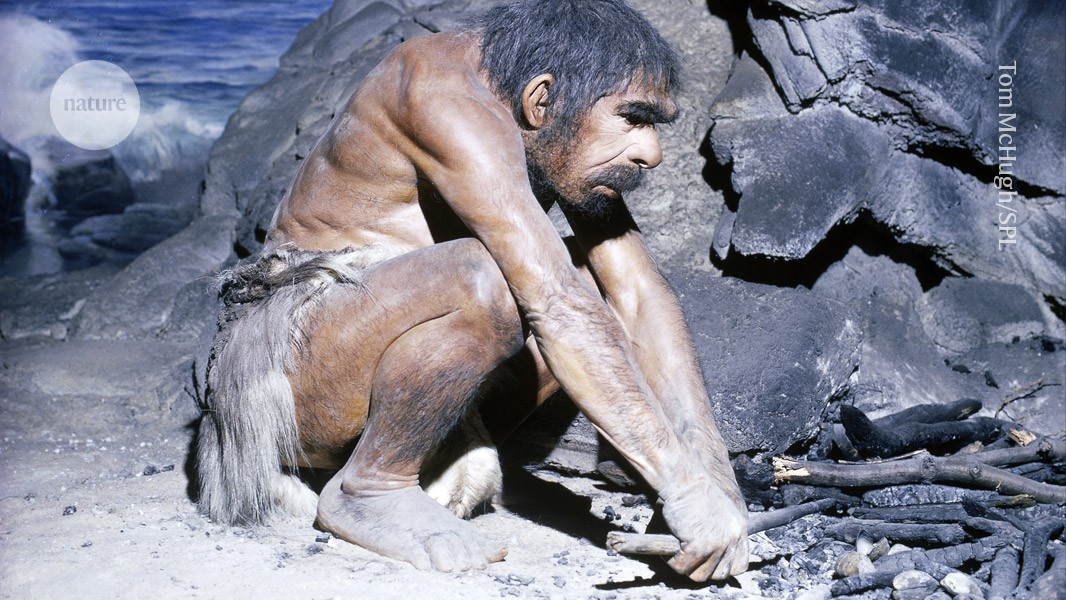These Neanderthal fire pits offer an extraordinarily precise snapshot of ancient life

Researchers used traces of Earth’s changing magnetic field in sediments to identify the activity of ancient humans

Neanderthal fire pits reveal when the ancient humans were present at sites.Credit: Tom McHugh/Science Photo Library
More than 50,000 years ago, Neanderthals passed through a rugged river valley in Spain, leaving behind stone tools, animal bones and dozens of fire pits (and the world’s oldest-known fossil of human poo). These traces were found in the same layer of soil, suggesting that they were left by a single group of Neanderthals (Homo neanderthalensis) and around the same time.
Researchers using a transformative new dating technique have now found that the hearths were established over a period of more than 200 years. The results were reported in Nature1 on 5 June.
Such precise timescales are practically unheard of in analyses of the deep human past — estimates usually have error margins of thousands of years — and raise the possibility of uncovering changes in human activity that were previously elusive.
“This information will completely change the way we can interpret archaeological assemblages,” says Ségolène Vandevelde, an archaeologist at the University of Quebec at Chicoutimi in Saguenay.
Ancient layers
The Neanderthal hearths at El Salt, an archaeological site in western Spain, occur in a single archaeological layer, which are usually interpreted as contemporaneous. Previous dating work suggested that the fires were set around 52,000 years ago — plus or minus a few thousand years2.
But Ángela Herrejón-Lagunilla, an archaeologist at the University of Burgos in Spain, and her colleagues suspected that those error bars hid the site’s true history. To date the Neanderthals’ time at El Salt more precisely, the researchers analysed magnetic minerals recovered from several hearths found within a few metres of each other. These minerals record the orientation of Earth’s fluctuating magnetic field at the time the fire was last extinguished.

El Salt, an archaeological site in western Spain, which has the remains of several Neanderthal hearths.Credit: University of Bologna
Herrejón-Lagunilla and her colleagues then modelled subtle changes in Earth’s magnetic field around 52,000 years ago — on the basis of measurements of more recent shifts — and, using this information, estimated the time between when the hearths were last used. Their analysis showed that the oldest and youngest fire pits were last lit at least 200 years apart, with decades-long intervals between the use of different hearths. This indicates that groups of Neanderthals regularly visited the site over many generations.
The length of time we found was surprisingly long, says Herrejón-Lagunilla, and it might prompt researchers to reconsider the number of Neanderthals that occupied El Salt at any given time, and to look anew for subtle changes in stone tools and other traces of human occupation. The same approach could be applied more widely — anywhere and anytime ancient humans and their relatives made fires. The controlled use of fire dates back to at least 790,000 years.
“This has the potential to reveal new insights into how ancient humans lived, moved and organized themselves in social groups,” says Thomas Higham, an archaeological scientist at the University of Vienna.
“The main potential is to reach a timescale close to the human life,” adds Herrejón-Lagunilla. “We can’t understand 200 years as a single moment. That’s crazy.”
doi: https://doi.org/10.1038/d41586-024-01688-z
Read the related News & Views article: ‘Precision dating pinpoints time between use of ancient fireplaces’.
This story originally appeared on: Nature - Author:Ewen Callaway

















